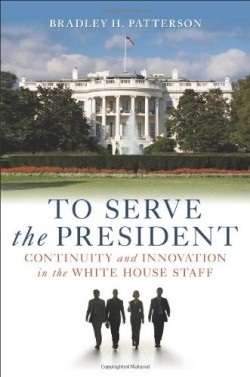To Serve the President
Continuity and Innovation in the White House Staff
“How do you intend to get advice from people you surround yourself—how do you intend to set up your Oval Office so that people will come in and give you their advice,” posits President George Bush. The author provides the convincing answer: through a well-organized White House staff, an administrative feat that is much easier described than done. This exhaustive encyclopedic account describes the functions and responsibilities of the Bush White House staff, a massive bureaucracy of 135 offices, 6,586 employees, and a 2008 budget of $1.6 billion.
Few, if any, public administration specialists write with more authority than Patterson. The author has worked for sixty-three years in Washington, D.C., and has spent fourteen of those years on the staffs of presidents Eisenhower, Nixon, and Ford. His two previous books, Ring of Power and The White House Staff: Inside the West Wing and Beyond investigate the structure and operation of the staffs of these presidents.
The author includes comments from his interviews with several key Bush staff officials, which illuminate and keep the book moving at a brisk pace. Bush is commended for his three staff initiatives: the Office of Faith Based and Community Initiatives, which channels funding for domestic programs through religious organizations; the USA Freedom Corps Office, an initiative that promotes volunteer work; and, most important, the Department of Homeland Security, which has the critical job of coordinating responses to terrorist threats and other emergencies.
In addition, the president is credited for modernizing the White House Situation Room, actually a thirteen-room complex, with state-of-the-art technology, so that the President could respond to all challenges. President Bush has also renovated the James S. Brady Press Room and the Eisenhower Office Building, important modifications that will benefit future presidents.
Arguably, the most important lesson from this book, one that Patterson stressed in his earlier books, is that the White House Staff and not the Cabinet is the center of political power. David Broder, the highly regarded Washington Post commentator, praised this book in his July 27 column and challenged all senators and presidential candidates to read it. Broder’s charge also applies to government specialists and informed readers who want to gain insight into the inner-workings of the executive branch.
Disclosure: This article is not an endorsement, but a review. The publisher of this book provided free copies of the book to have their book reviewed by a professional reviewer. No fee was paid by the publisher for this review. Foreword Reviews only recommends books that we love. Foreword Magazine, Inc. is disclosing this in accordance with the Federal Trade Commission’s 16 CFR, Part 255.

